Leadership Styles in Business Crisis: Report and Analysis
VerifiedAdded on 2022/11/28
|16
|3503
|296
Report
AI Summary
This report analyzes a case study involving a business facing a crisis, focusing on the leadership styles employed by the CEO. It begins with an executive summary and an introduction to leadership styles in crisis situations, emphasizing the importance of adapting leadership approaches. The report then delves into the case study, evaluating the issues and problems faced by the organization, such as lack of focus and inadequate cost accounting. It identifies the leadership styles implemented, primarily democratic and directive approaches, and assesses their effectiveness in addressing the crisis. The CEO's actions, including implementing a four-day workweek and layoffs, are examined in the context of democratic leadership, considering the involvement of the union leaders and the chairman. The report also highlights the implementation of an autocratic approach in certain areas. The report concludes by recommending strategies for handling crisis situations, such as balancing task performance and people's needs, and providing a clear vision for the company. The analysis reveals that the CEO combined autocratic and participative leadership styles to navigate the crisis, with an emphasis on making tough decisions for the organization's future.
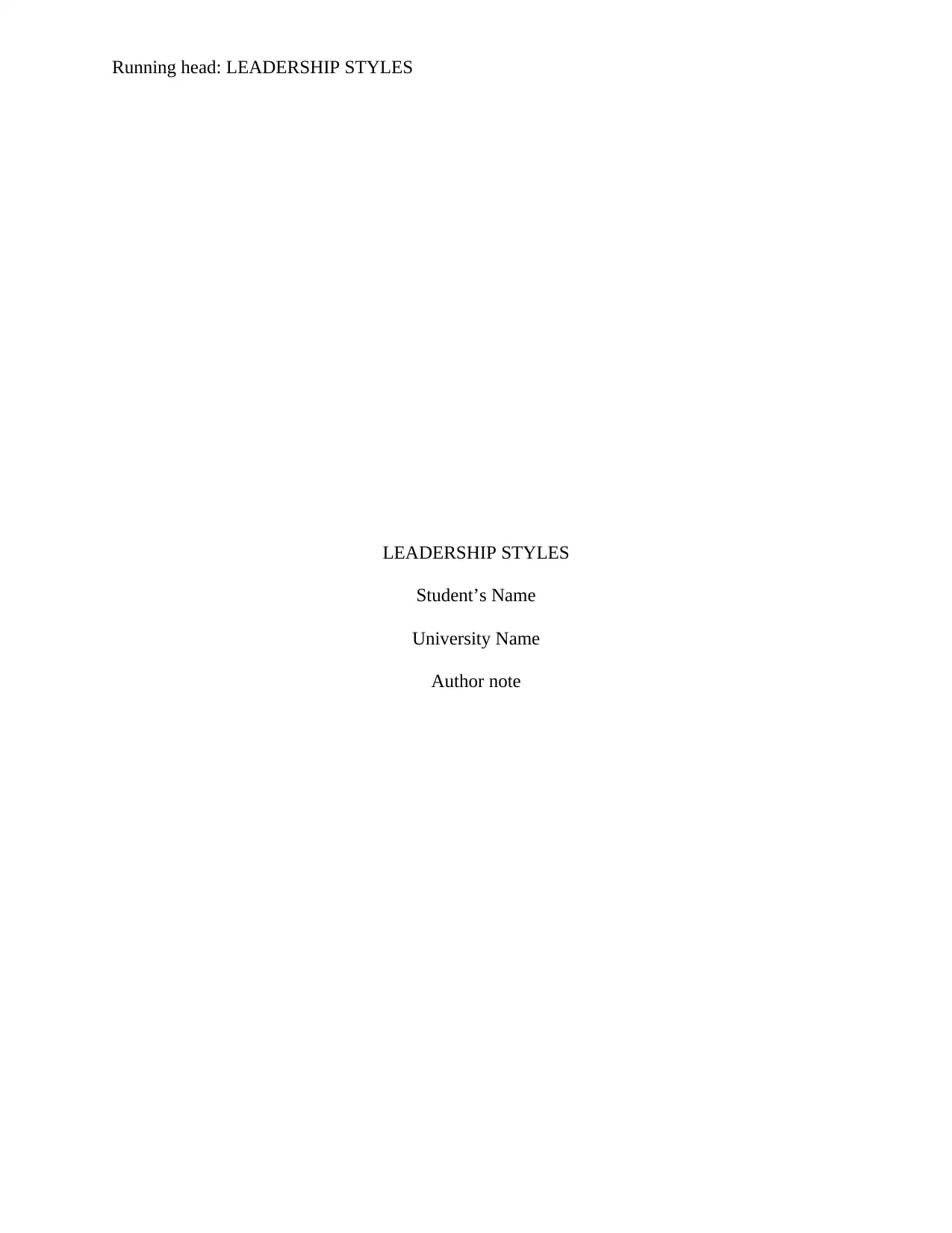
Running head: LEADERSHIP STYLES
LEADERSHIP STYLES
Student’s Name
University Name
Author note
LEADERSHIP STYLES
Student’s Name
University Name
Author note
Paraphrase This Document
Need a fresh take? Get an instant paraphrase of this document with our AI Paraphraser
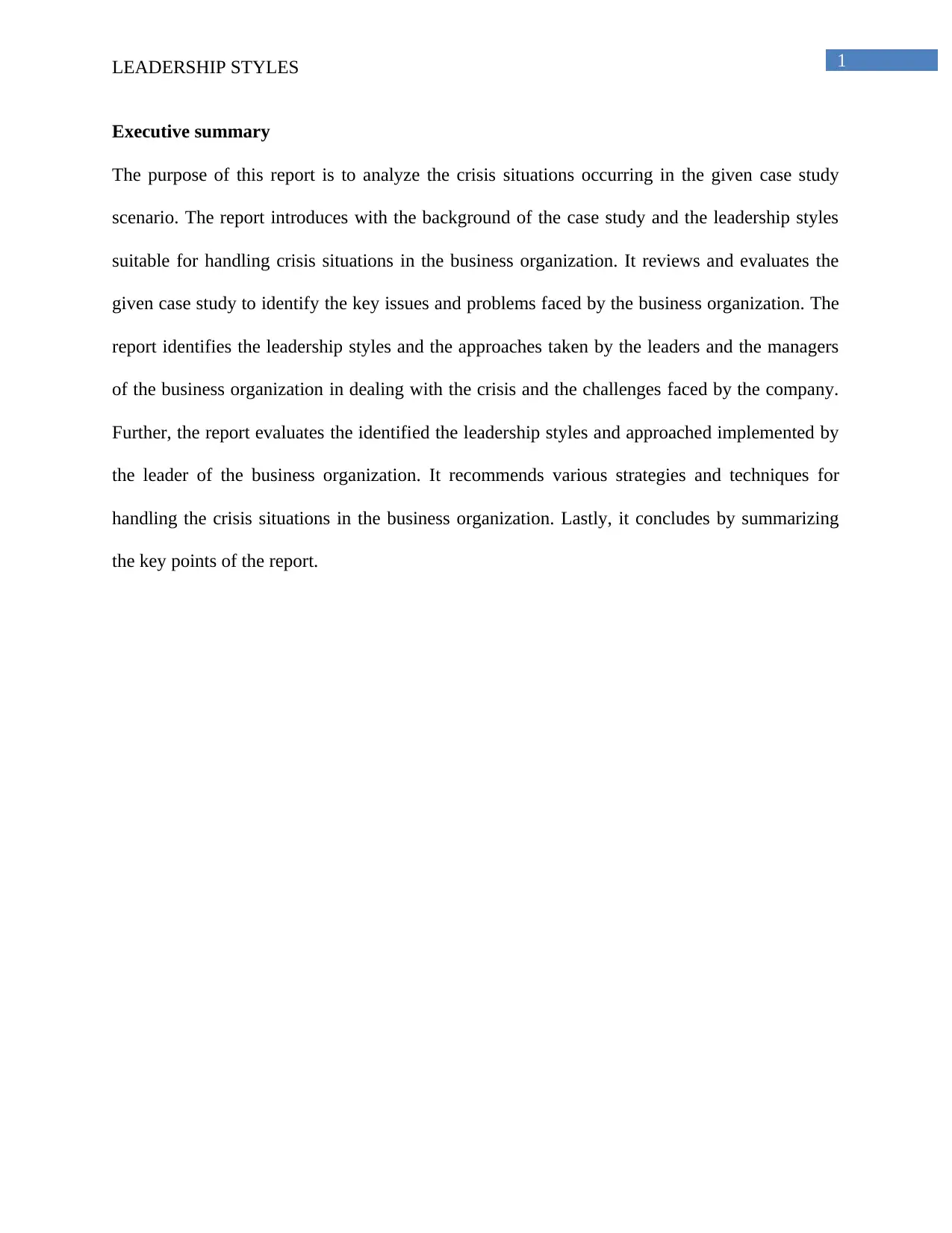
1LEADERSHIP STYLES
Executive summary
The purpose of this report is to analyze the crisis situations occurring in the given case study
scenario. The report introduces with the background of the case study and the leadership styles
suitable for handling crisis situations in the business organization. It reviews and evaluates the
given case study to identify the key issues and problems faced by the business organization. The
report identifies the leadership styles and the approaches taken by the leaders and the managers
of the business organization in dealing with the crisis and the challenges faced by the company.
Further, the report evaluates the identified the leadership styles and approached implemented by
the leader of the business organization. It recommends various strategies and techniques for
handling the crisis situations in the business organization. Lastly, it concludes by summarizing
the key points of the report.
Executive summary
The purpose of this report is to analyze the crisis situations occurring in the given case study
scenario. The report introduces with the background of the case study and the leadership styles
suitable for handling crisis situations in the business organization. It reviews and evaluates the
given case study to identify the key issues and problems faced by the business organization. The
report identifies the leadership styles and the approaches taken by the leaders and the managers
of the business organization in dealing with the crisis and the challenges faced by the company.
Further, the report evaluates the identified the leadership styles and approached implemented by
the leader of the business organization. It recommends various strategies and techniques for
handling the crisis situations in the business organization. Lastly, it concludes by summarizing
the key points of the report.
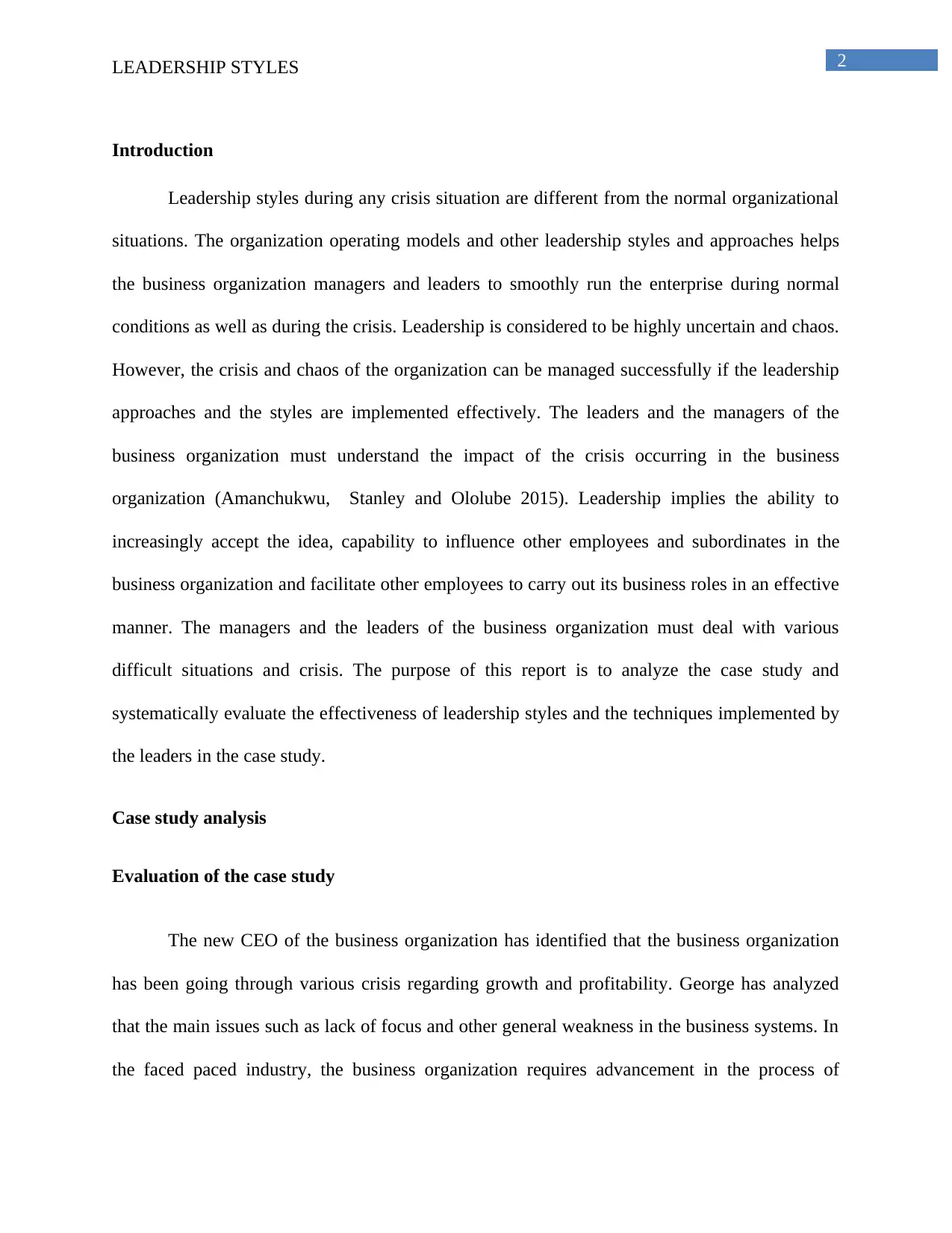
2LEADERSHIP STYLES
Introduction
Leadership styles during any crisis situation are different from the normal organizational
situations. The organization operating models and other leadership styles and approaches helps
the business organization managers and leaders to smoothly run the enterprise during normal
conditions as well as during the crisis. Leadership is considered to be highly uncertain and chaos.
However, the crisis and chaos of the organization can be managed successfully if the leadership
approaches and the styles are implemented effectively. The leaders and the managers of the
business organization must understand the impact of the crisis occurring in the business
organization (Amanchukwu, Stanley and Ololube 2015). Leadership implies the ability to
increasingly accept the idea, capability to influence other employees and subordinates in the
business organization and facilitate other employees to carry out its business roles in an effective
manner. The managers and the leaders of the business organization must deal with various
difficult situations and crisis. The purpose of this report is to analyze the case study and
systematically evaluate the effectiveness of leadership styles and the techniques implemented by
the leaders in the case study.
Case study analysis
Evaluation of the case study
The new CEO of the business organization has identified that the business organization
has been going through various crisis regarding growth and profitability. George has analyzed
that the main issues such as lack of focus and other general weakness in the business systems. In
the faced paced industry, the business organization requires advancement in the process of
Introduction
Leadership styles during any crisis situation are different from the normal organizational
situations. The organization operating models and other leadership styles and approaches helps
the business organization managers and leaders to smoothly run the enterprise during normal
conditions as well as during the crisis. Leadership is considered to be highly uncertain and chaos.
However, the crisis and chaos of the organization can be managed successfully if the leadership
approaches and the styles are implemented effectively. The leaders and the managers of the
business organization must understand the impact of the crisis occurring in the business
organization (Amanchukwu, Stanley and Ololube 2015). Leadership implies the ability to
increasingly accept the idea, capability to influence other employees and subordinates in the
business organization and facilitate other employees to carry out its business roles in an effective
manner. The managers and the leaders of the business organization must deal with various
difficult situations and crisis. The purpose of this report is to analyze the case study and
systematically evaluate the effectiveness of leadership styles and the techniques implemented by
the leaders in the case study.
Case study analysis
Evaluation of the case study
The new CEO of the business organization has identified that the business organization
has been going through various crisis regarding growth and profitability. George has analyzed
that the main issues such as lack of focus and other general weakness in the business systems. In
the faced paced industry, the business organization requires advancement in the process of
⊘ This is a preview!⊘
Do you want full access?
Subscribe today to unlock all pages.

Trusted by 1+ million students worldwide
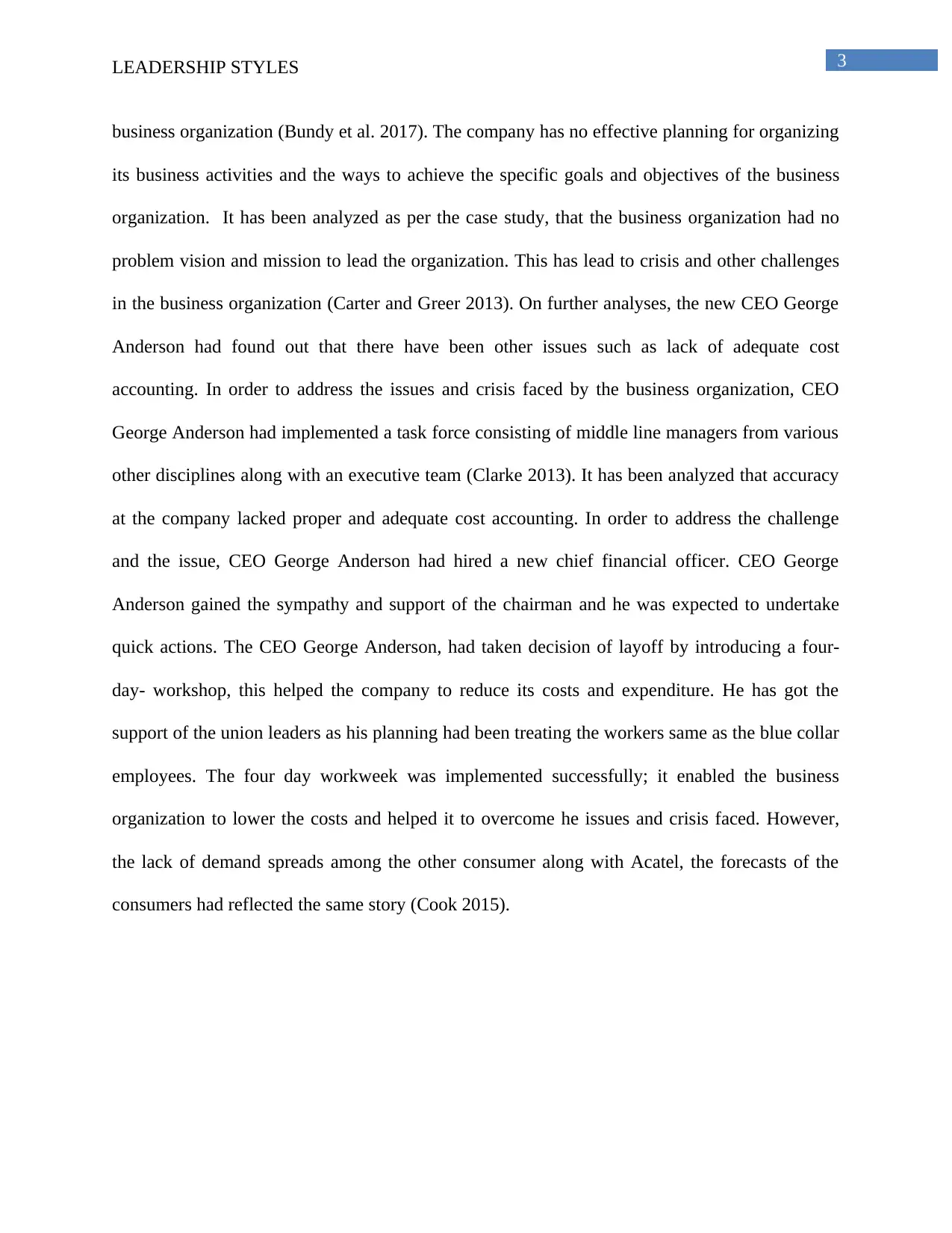
3LEADERSHIP STYLES
business organization (Bundy et al. 2017). The company has no effective planning for organizing
its business activities and the ways to achieve the specific goals and objectives of the business
organization. It has been analyzed as per the case study, that the business organization had no
problem vision and mission to lead the organization. This has lead to crisis and other challenges
in the business organization (Carter and Greer 2013). On further analyses, the new CEO George
Anderson had found out that there have been other issues such as lack of adequate cost
accounting. In order to address the issues and crisis faced by the business organization, CEO
George Anderson had implemented a task force consisting of middle line managers from various
other disciplines along with an executive team (Clarke 2013). It has been analyzed that accuracy
at the company lacked proper and adequate cost accounting. In order to address the challenge
and the issue, CEO George Anderson had hired a new chief financial officer. CEO George
Anderson gained the sympathy and support of the chairman and he was expected to undertake
quick actions. The CEO George Anderson, had taken decision of layoff by introducing a four-
day- workshop, this helped the company to reduce its costs and expenditure. He has got the
support of the union leaders as his planning had been treating the workers same as the blue collar
employees. The four day workweek was implemented successfully; it enabled the business
organization to lower the costs and helped it to overcome he issues and crisis faced. However,
the lack of demand spreads among the other consumer along with Acatel, the forecasts of the
consumers had reflected the same story (Cook 2015).
business organization (Bundy et al. 2017). The company has no effective planning for organizing
its business activities and the ways to achieve the specific goals and objectives of the business
organization. It has been analyzed as per the case study, that the business organization had no
problem vision and mission to lead the organization. This has lead to crisis and other challenges
in the business organization (Carter and Greer 2013). On further analyses, the new CEO George
Anderson had found out that there have been other issues such as lack of adequate cost
accounting. In order to address the issues and crisis faced by the business organization, CEO
George Anderson had implemented a task force consisting of middle line managers from various
other disciplines along with an executive team (Clarke 2013). It has been analyzed that accuracy
at the company lacked proper and adequate cost accounting. In order to address the challenge
and the issue, CEO George Anderson had hired a new chief financial officer. CEO George
Anderson gained the sympathy and support of the chairman and he was expected to undertake
quick actions. The CEO George Anderson, had taken decision of layoff by introducing a four-
day- workshop, this helped the company to reduce its costs and expenditure. He has got the
support of the union leaders as his planning had been treating the workers same as the blue collar
employees. The four day workweek was implemented successfully; it enabled the business
organization to lower the costs and helped it to overcome he issues and crisis faced. However,
the lack of demand spreads among the other consumer along with Acatel, the forecasts of the
consumers had reflected the same story (Cook 2015).
Paraphrase This Document
Need a fresh take? Get an instant paraphrase of this document with our AI Paraphraser
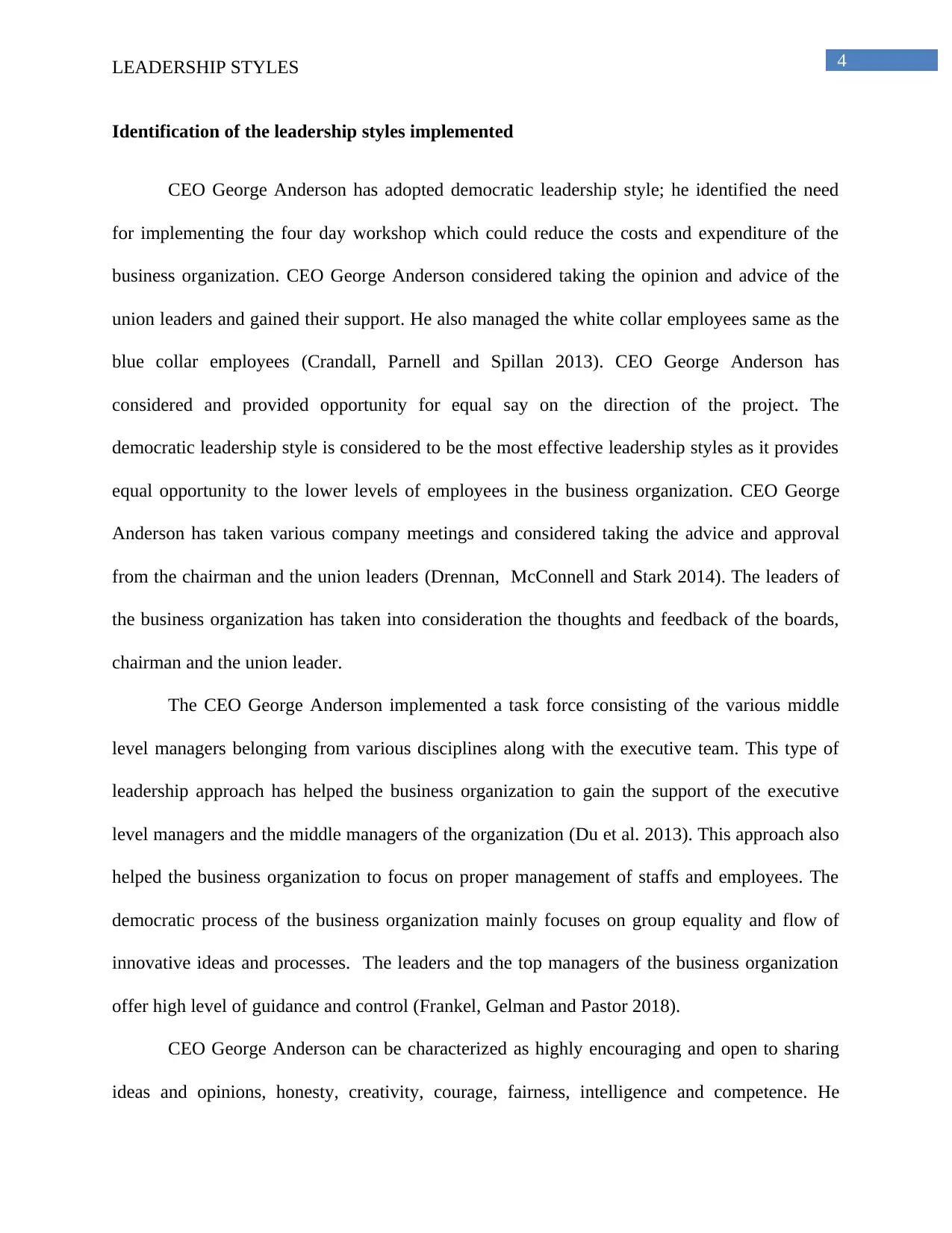
4LEADERSHIP STYLES
Identification of the leadership styles implemented
CEO George Anderson has adopted democratic leadership style; he identified the need
for implementing the four day workshop which could reduce the costs and expenditure of the
business organization. CEO George Anderson considered taking the opinion and advice of the
union leaders and gained their support. He also managed the white collar employees same as the
blue collar employees (Crandall, Parnell and Spillan 2013). CEO George Anderson has
considered and provided opportunity for equal say on the direction of the project. The
democratic leadership style is considered to be the most effective leadership styles as it provides
equal opportunity to the lower levels of employees in the business organization. CEO George
Anderson has taken various company meetings and considered taking the advice and approval
from the chairman and the union leaders (Drennan, McConnell and Stark 2014). The leaders of
the business organization has taken into consideration the thoughts and feedback of the boards,
chairman and the union leader.
The CEO George Anderson implemented a task force consisting of the various middle
level managers belonging from various disciplines along with the executive team. This type of
leadership approach has helped the business organization to gain the support of the executive
level managers and the middle managers of the organization (Du et al. 2013). This approach also
helped the business organization to focus on proper management of staffs and employees. The
democratic process of the business organization mainly focuses on group equality and flow of
innovative ideas and processes. The leaders and the top managers of the business organization
offer high level of guidance and control (Frankel, Gelman and Pastor 2018).
CEO George Anderson can be characterized as highly encouraging and open to sharing
ideas and opinions, honesty, creativity, courage, fairness, intelligence and competence. He
Identification of the leadership styles implemented
CEO George Anderson has adopted democratic leadership style; he identified the need
for implementing the four day workshop which could reduce the costs and expenditure of the
business organization. CEO George Anderson considered taking the opinion and advice of the
union leaders and gained their support. He also managed the white collar employees same as the
blue collar employees (Crandall, Parnell and Spillan 2013). CEO George Anderson has
considered and provided opportunity for equal say on the direction of the project. The
democratic leadership style is considered to be the most effective leadership styles as it provides
equal opportunity to the lower levels of employees in the business organization. CEO George
Anderson has taken various company meetings and considered taking the advice and approval
from the chairman and the union leaders (Drennan, McConnell and Stark 2014). The leaders of
the business organization has taken into consideration the thoughts and feedback of the boards,
chairman and the union leader.
The CEO George Anderson implemented a task force consisting of the various middle
level managers belonging from various disciplines along with the executive team. This type of
leadership approach has helped the business organization to gain the support of the executive
level managers and the middle managers of the organization (Du et al. 2013). This approach also
helped the business organization to focus on proper management of staffs and employees. The
democratic process of the business organization mainly focuses on group equality and flow of
innovative ideas and processes. The leaders and the top managers of the business organization
offer high level of guidance and control (Frankel, Gelman and Pastor 2018).
CEO George Anderson can be characterized as highly encouraging and open to sharing
ideas and opinions, honesty, creativity, courage, fairness, intelligence and competence. He
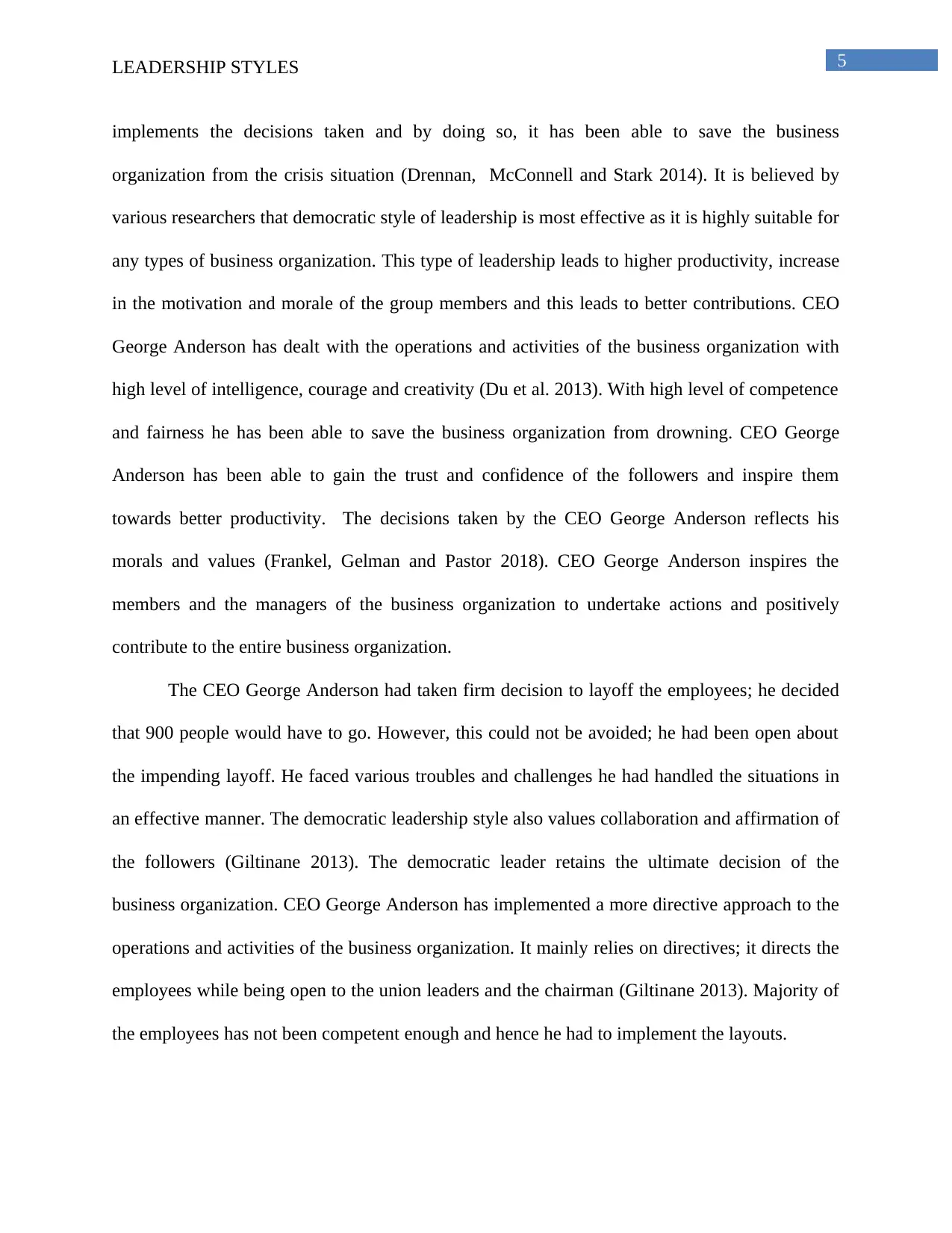
5LEADERSHIP STYLES
implements the decisions taken and by doing so, it has been able to save the business
organization from the crisis situation (Drennan, McConnell and Stark 2014). It is believed by
various researchers that democratic style of leadership is most effective as it is highly suitable for
any types of business organization. This type of leadership leads to higher productivity, increase
in the motivation and morale of the group members and this leads to better contributions. CEO
George Anderson has dealt with the operations and activities of the business organization with
high level of intelligence, courage and creativity (Du et al. 2013). With high level of competence
and fairness he has been able to save the business organization from drowning. CEO George
Anderson has been able to gain the trust and confidence of the followers and inspire them
towards better productivity. The decisions taken by the CEO George Anderson reflects his
morals and values (Frankel, Gelman and Pastor 2018). CEO George Anderson inspires the
members and the managers of the business organization to undertake actions and positively
contribute to the entire business organization.
The CEO George Anderson had taken firm decision to layoff the employees; he decided
that 900 people would have to go. However, this could not be avoided; he had been open about
the impending layoff. He faced various troubles and challenges he had handled the situations in
an effective manner. The democratic leadership style also values collaboration and affirmation of
the followers (Giltinane 2013). The democratic leader retains the ultimate decision of the
business organization. CEO George Anderson has implemented a more directive approach to the
operations and activities of the business organization. It mainly relies on directives; it directs the
employees while being open to the union leaders and the chairman (Giltinane 2013). Majority of
the employees has not been competent enough and hence he had to implement the layouts.
implements the decisions taken and by doing so, it has been able to save the business
organization from the crisis situation (Drennan, McConnell and Stark 2014). It is believed by
various researchers that democratic style of leadership is most effective as it is highly suitable for
any types of business organization. This type of leadership leads to higher productivity, increase
in the motivation and morale of the group members and this leads to better contributions. CEO
George Anderson has dealt with the operations and activities of the business organization with
high level of intelligence, courage and creativity (Du et al. 2013). With high level of competence
and fairness he has been able to save the business organization from drowning. CEO George
Anderson has been able to gain the trust and confidence of the followers and inspire them
towards better productivity. The decisions taken by the CEO George Anderson reflects his
morals and values (Frankel, Gelman and Pastor 2018). CEO George Anderson inspires the
members and the managers of the business organization to undertake actions and positively
contribute to the entire business organization.
The CEO George Anderson had taken firm decision to layoff the employees; he decided
that 900 people would have to go. However, this could not be avoided; he had been open about
the impending layoff. He faced various troubles and challenges he had handled the situations in
an effective manner. The democratic leadership style also values collaboration and affirmation of
the followers (Giltinane 2013). The democratic leader retains the ultimate decision of the
business organization. CEO George Anderson has implemented a more directive approach to the
operations and activities of the business organization. It mainly relies on directives; it directs the
employees while being open to the union leaders and the chairman (Giltinane 2013). Majority of
the employees has not been competent enough and hence he had to implement the layouts.
⊘ This is a preview!⊘
Do you want full access?
Subscribe today to unlock all pages.

Trusted by 1+ million students worldwide
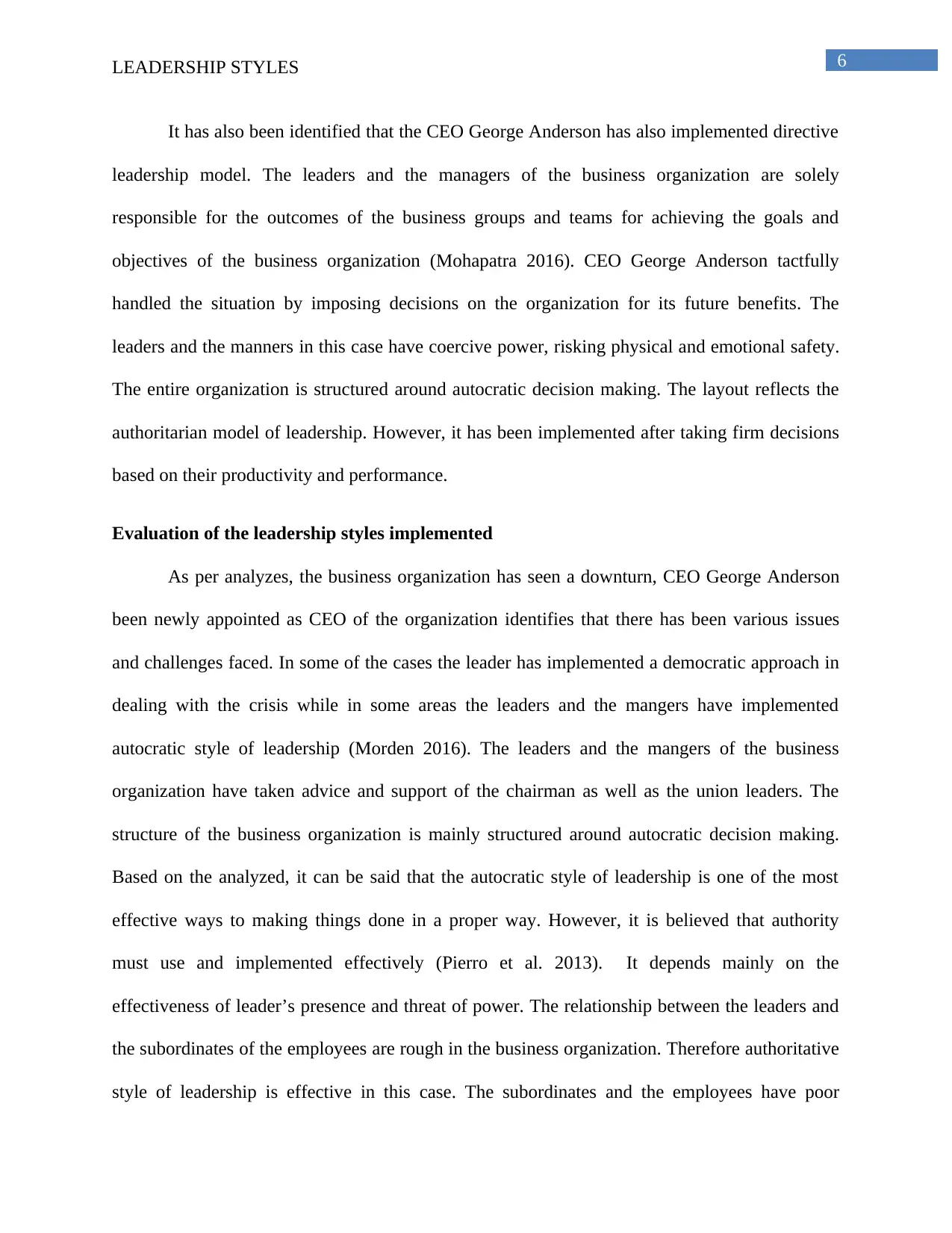
6LEADERSHIP STYLES
It has also been identified that the CEO George Anderson has also implemented directive
leadership model. The leaders and the managers of the business organization are solely
responsible for the outcomes of the business groups and teams for achieving the goals and
objectives of the business organization (Mohapatra 2016). CEO George Anderson tactfully
handled the situation by imposing decisions on the organization for its future benefits. The
leaders and the manners in this case have coercive power, risking physical and emotional safety.
The entire organization is structured around autocratic decision making. The layout reflects the
authoritarian model of leadership. However, it has been implemented after taking firm decisions
based on their productivity and performance.
Evaluation of the leadership styles implemented
As per analyzes, the business organization has seen a downturn, CEO George Anderson
been newly appointed as CEO of the organization identifies that there has been various issues
and challenges faced. In some of the cases the leader has implemented a democratic approach in
dealing with the crisis while in some areas the leaders and the mangers have implemented
autocratic style of leadership (Morden 2016). The leaders and the mangers of the business
organization have taken advice and support of the chairman as well as the union leaders. The
structure of the business organization is mainly structured around autocratic decision making.
Based on the analyzed, it can be said that the autocratic style of leadership is one of the most
effective ways to making things done in a proper way. However, it is believed that authority
must use and implemented effectively (Pierro et al. 2013). It depends mainly on the
effectiveness of leader’s presence and threat of power. The relationship between the leaders and
the subordinates of the employees are rough in the business organization. Therefore authoritative
style of leadership is effective in this case. The subordinates and the employees have poor
It has also been identified that the CEO George Anderson has also implemented directive
leadership model. The leaders and the managers of the business organization are solely
responsible for the outcomes of the business groups and teams for achieving the goals and
objectives of the business organization (Mohapatra 2016). CEO George Anderson tactfully
handled the situation by imposing decisions on the organization for its future benefits. The
leaders and the manners in this case have coercive power, risking physical and emotional safety.
The entire organization is structured around autocratic decision making. The layout reflects the
authoritarian model of leadership. However, it has been implemented after taking firm decisions
based on their productivity and performance.
Evaluation of the leadership styles implemented
As per analyzes, the business organization has seen a downturn, CEO George Anderson
been newly appointed as CEO of the organization identifies that there has been various issues
and challenges faced. In some of the cases the leader has implemented a democratic approach in
dealing with the crisis while in some areas the leaders and the mangers have implemented
autocratic style of leadership (Morden 2016). The leaders and the mangers of the business
organization have taken advice and support of the chairman as well as the union leaders. The
structure of the business organization is mainly structured around autocratic decision making.
Based on the analyzed, it can be said that the autocratic style of leadership is one of the most
effective ways to making things done in a proper way. However, it is believed that authority
must use and implemented effectively (Pierro et al. 2013). It depends mainly on the
effectiveness of leader’s presence and threat of power. The relationship between the leaders and
the subordinates of the employees are rough in the business organization. Therefore authoritative
style of leadership is effective in this case. The subordinates and the employees have poor
Paraphrase This Document
Need a fresh take? Get an instant paraphrase of this document with our AI Paraphraser
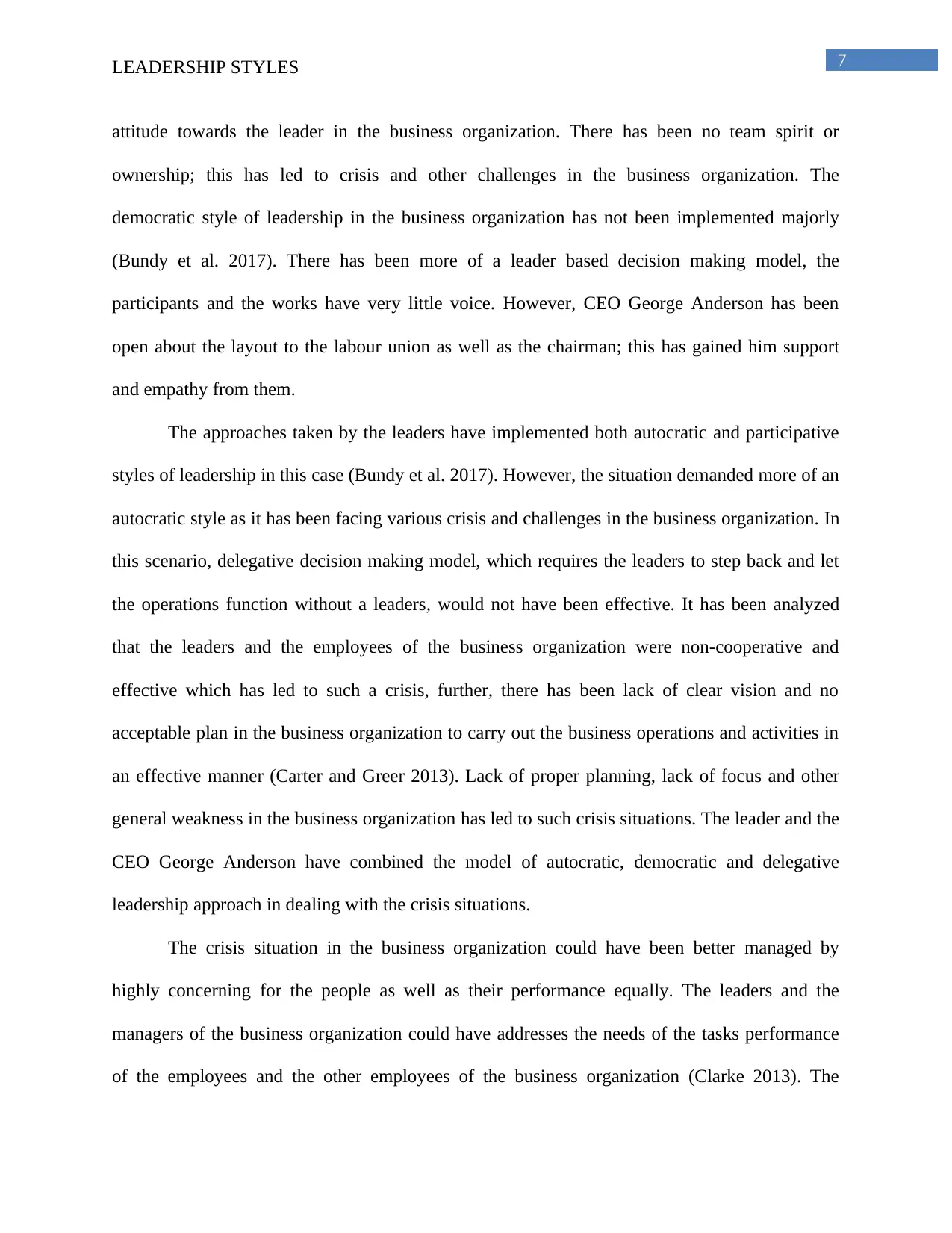
7LEADERSHIP STYLES
attitude towards the leader in the business organization. There has been no team spirit or
ownership; this has led to crisis and other challenges in the business organization. The
democratic style of leadership in the business organization has not been implemented majorly
(Bundy et al. 2017). There has been more of a leader based decision making model, the
participants and the works have very little voice. However, CEO George Anderson has been
open about the layout to the labour union as well as the chairman; this has gained him support
and empathy from them.
The approaches taken by the leaders have implemented both autocratic and participative
styles of leadership in this case (Bundy et al. 2017). However, the situation demanded more of an
autocratic style as it has been facing various crisis and challenges in the business organization. In
this scenario, delegative decision making model, which requires the leaders to step back and let
the operations function without a leaders, would not have been effective. It has been analyzed
that the leaders and the employees of the business organization were non-cooperative and
effective which has led to such a crisis, further, there has been lack of clear vision and no
acceptable plan in the business organization to carry out the business operations and activities in
an effective manner (Carter and Greer 2013). Lack of proper planning, lack of focus and other
general weakness in the business organization has led to such crisis situations. The leader and the
CEO George Anderson have combined the model of autocratic, democratic and delegative
leadership approach in dealing with the crisis situations.
The crisis situation in the business organization could have been better managed by
highly concerning for the people as well as their performance equally. The leaders and the
managers of the business organization could have addresses the needs of the tasks performance
of the employees and the other employees of the business organization (Clarke 2013). The
attitude towards the leader in the business organization. There has been no team spirit or
ownership; this has led to crisis and other challenges in the business organization. The
democratic style of leadership in the business organization has not been implemented majorly
(Bundy et al. 2017). There has been more of a leader based decision making model, the
participants and the works have very little voice. However, CEO George Anderson has been
open about the layout to the labour union as well as the chairman; this has gained him support
and empathy from them.
The approaches taken by the leaders have implemented both autocratic and participative
styles of leadership in this case (Bundy et al. 2017). However, the situation demanded more of an
autocratic style as it has been facing various crisis and challenges in the business organization. In
this scenario, delegative decision making model, which requires the leaders to step back and let
the operations function without a leaders, would not have been effective. It has been analyzed
that the leaders and the employees of the business organization were non-cooperative and
effective which has led to such a crisis, further, there has been lack of clear vision and no
acceptable plan in the business organization to carry out the business operations and activities in
an effective manner (Carter and Greer 2013). Lack of proper planning, lack of focus and other
general weakness in the business organization has led to such crisis situations. The leader and the
CEO George Anderson have combined the model of autocratic, democratic and delegative
leadership approach in dealing with the crisis situations.
The crisis situation in the business organization could have been better managed by
highly concerning for the people as well as their performance equally. The leaders and the
managers of the business organization could have addresses the needs of the tasks performance
of the employees and the other employees of the business organization (Clarke 2013). The
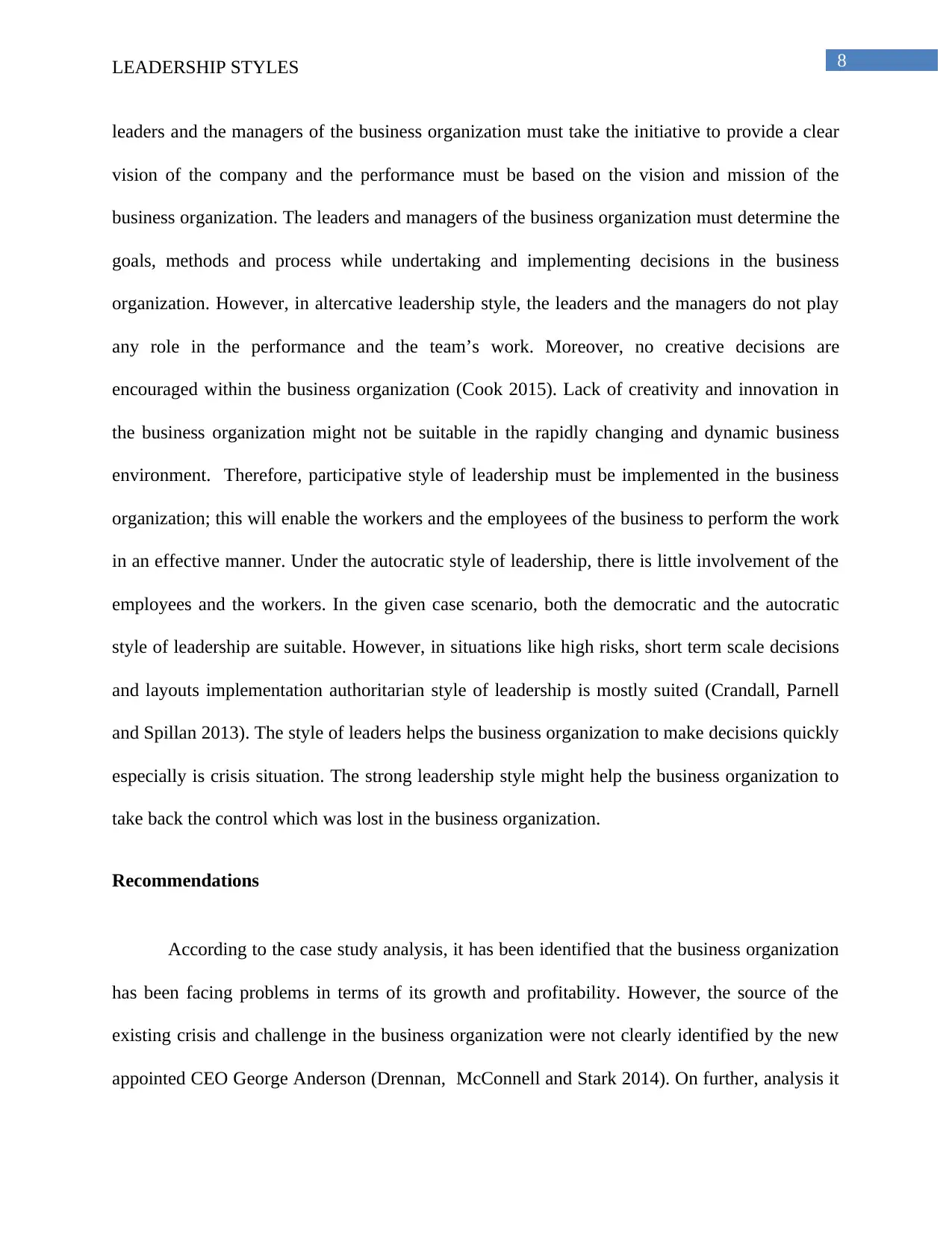
8LEADERSHIP STYLES
leaders and the managers of the business organization must take the initiative to provide a clear
vision of the company and the performance must be based on the vision and mission of the
business organization. The leaders and managers of the business organization must determine the
goals, methods and process while undertaking and implementing decisions in the business
organization. However, in altercative leadership style, the leaders and the managers do not play
any role in the performance and the team’s work. Moreover, no creative decisions are
encouraged within the business organization (Cook 2015). Lack of creativity and innovation in
the business organization might not be suitable in the rapidly changing and dynamic business
environment. Therefore, participative style of leadership must be implemented in the business
organization; this will enable the workers and the employees of the business to perform the work
in an effective manner. Under the autocratic style of leadership, there is little involvement of the
employees and the workers. In the given case scenario, both the democratic and the autocratic
style of leadership are suitable. However, in situations like high risks, short term scale decisions
and layouts implementation authoritarian style of leadership is mostly suited (Crandall, Parnell
and Spillan 2013). The style of leaders helps the business organization to make decisions quickly
especially is crisis situation. The strong leadership style might help the business organization to
take back the control which was lost in the business organization.
Recommendations
According to the case study analysis, it has been identified that the business organization
has been facing problems in terms of its growth and profitability. However, the source of the
existing crisis and challenge in the business organization were not clearly identified by the new
appointed CEO George Anderson (Drennan, McConnell and Stark 2014). On further, analysis it
leaders and the managers of the business organization must take the initiative to provide a clear
vision of the company and the performance must be based on the vision and mission of the
business organization. The leaders and managers of the business organization must determine the
goals, methods and process while undertaking and implementing decisions in the business
organization. However, in altercative leadership style, the leaders and the managers do not play
any role in the performance and the team’s work. Moreover, no creative decisions are
encouraged within the business organization (Cook 2015). Lack of creativity and innovation in
the business organization might not be suitable in the rapidly changing and dynamic business
environment. Therefore, participative style of leadership must be implemented in the business
organization; this will enable the workers and the employees of the business to perform the work
in an effective manner. Under the autocratic style of leadership, there is little involvement of the
employees and the workers. In the given case scenario, both the democratic and the autocratic
style of leadership are suitable. However, in situations like high risks, short term scale decisions
and layouts implementation authoritarian style of leadership is mostly suited (Crandall, Parnell
and Spillan 2013). The style of leaders helps the business organization to make decisions quickly
especially is crisis situation. The strong leadership style might help the business organization to
take back the control which was lost in the business organization.
Recommendations
According to the case study analysis, it has been identified that the business organization
has been facing problems in terms of its growth and profitability. However, the source of the
existing crisis and challenge in the business organization were not clearly identified by the new
appointed CEO George Anderson (Drennan, McConnell and Stark 2014). On further, analysis it
⊘ This is a preview!⊘
Do you want full access?
Subscribe today to unlock all pages.

Trusted by 1+ million students worldwide
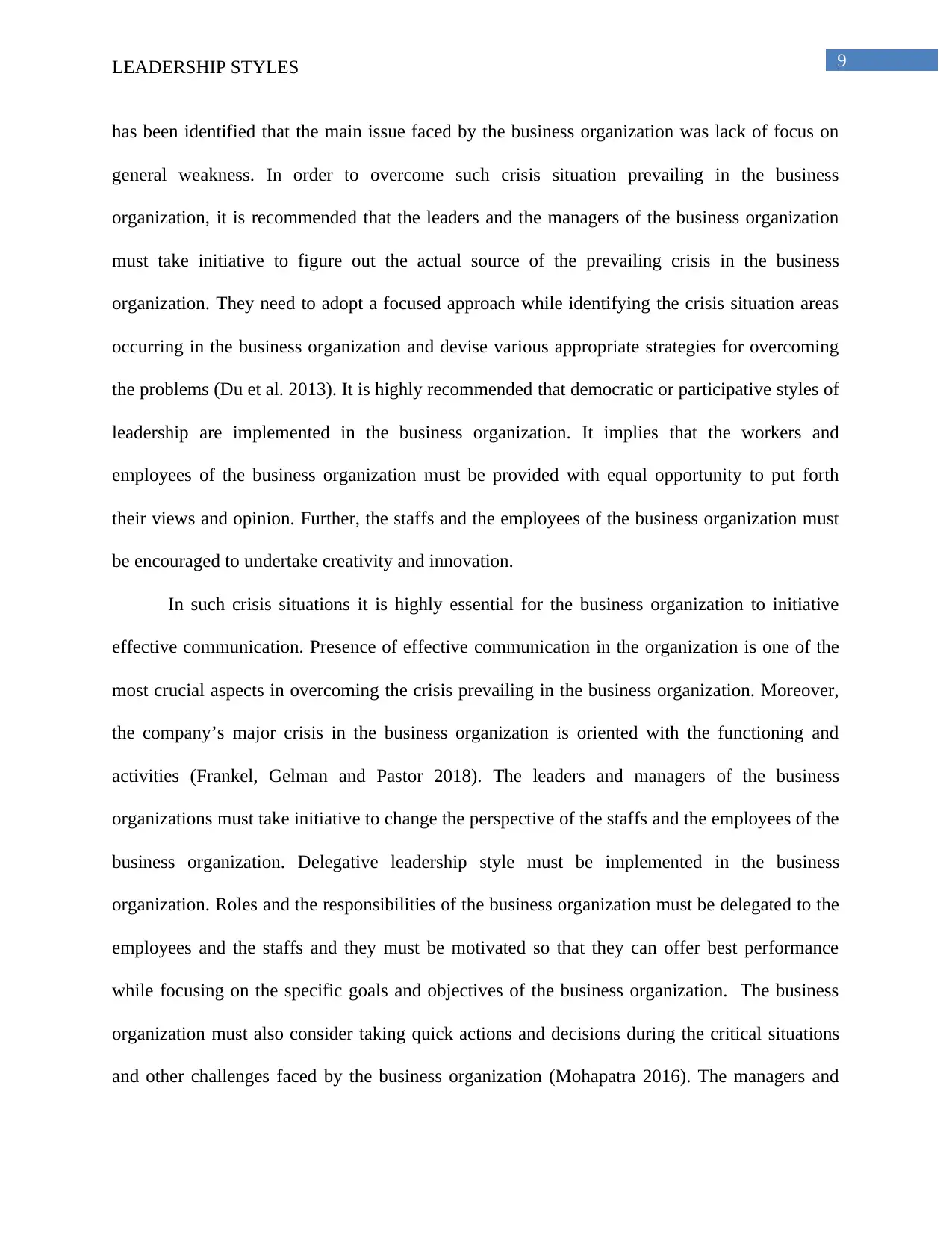
9LEADERSHIP STYLES
has been identified that the main issue faced by the business organization was lack of focus on
general weakness. In order to overcome such crisis situation prevailing in the business
organization, it is recommended that the leaders and the managers of the business organization
must take initiative to figure out the actual source of the prevailing crisis in the business
organization. They need to adopt a focused approach while identifying the crisis situation areas
occurring in the business organization and devise various appropriate strategies for overcoming
the problems (Du et al. 2013). It is highly recommended that democratic or participative styles of
leadership are implemented in the business organization. It implies that the workers and
employees of the business organization must be provided with equal opportunity to put forth
their views and opinion. Further, the staffs and the employees of the business organization must
be encouraged to undertake creativity and innovation.
In such crisis situations it is highly essential for the business organization to initiative
effective communication. Presence of effective communication in the organization is one of the
most crucial aspects in overcoming the crisis prevailing in the business organization. Moreover,
the company’s major crisis in the business organization is oriented with the functioning and
activities (Frankel, Gelman and Pastor 2018). The leaders and managers of the business
organizations must take initiative to change the perspective of the staffs and the employees of the
business organization. Delegative leadership style must be implemented in the business
organization. Roles and the responsibilities of the business organization must be delegated to the
employees and the staffs and they must be motivated so that they can offer best performance
while focusing on the specific goals and objectives of the business organization. The business
organization must also consider taking quick actions and decisions during the critical situations
and other challenges faced by the business organization (Mohapatra 2016). The managers and
has been identified that the main issue faced by the business organization was lack of focus on
general weakness. In order to overcome such crisis situation prevailing in the business
organization, it is recommended that the leaders and the managers of the business organization
must take initiative to figure out the actual source of the prevailing crisis in the business
organization. They need to adopt a focused approach while identifying the crisis situation areas
occurring in the business organization and devise various appropriate strategies for overcoming
the problems (Du et al. 2013). It is highly recommended that democratic or participative styles of
leadership are implemented in the business organization. It implies that the workers and
employees of the business organization must be provided with equal opportunity to put forth
their views and opinion. Further, the staffs and the employees of the business organization must
be encouraged to undertake creativity and innovation.
In such crisis situations it is highly essential for the business organization to initiative
effective communication. Presence of effective communication in the organization is one of the
most crucial aspects in overcoming the crisis prevailing in the business organization. Moreover,
the company’s major crisis in the business organization is oriented with the functioning and
activities (Frankel, Gelman and Pastor 2018). The leaders and managers of the business
organizations must take initiative to change the perspective of the staffs and the employees of the
business organization. Delegative leadership style must be implemented in the business
organization. Roles and the responsibilities of the business organization must be delegated to the
employees and the staffs and they must be motivated so that they can offer best performance
while focusing on the specific goals and objectives of the business organization. The business
organization must also consider taking quick actions and decisions during the critical situations
and other challenges faced by the business organization (Mohapatra 2016). The managers and
Paraphrase This Document
Need a fresh take? Get an instant paraphrase of this document with our AI Paraphraser
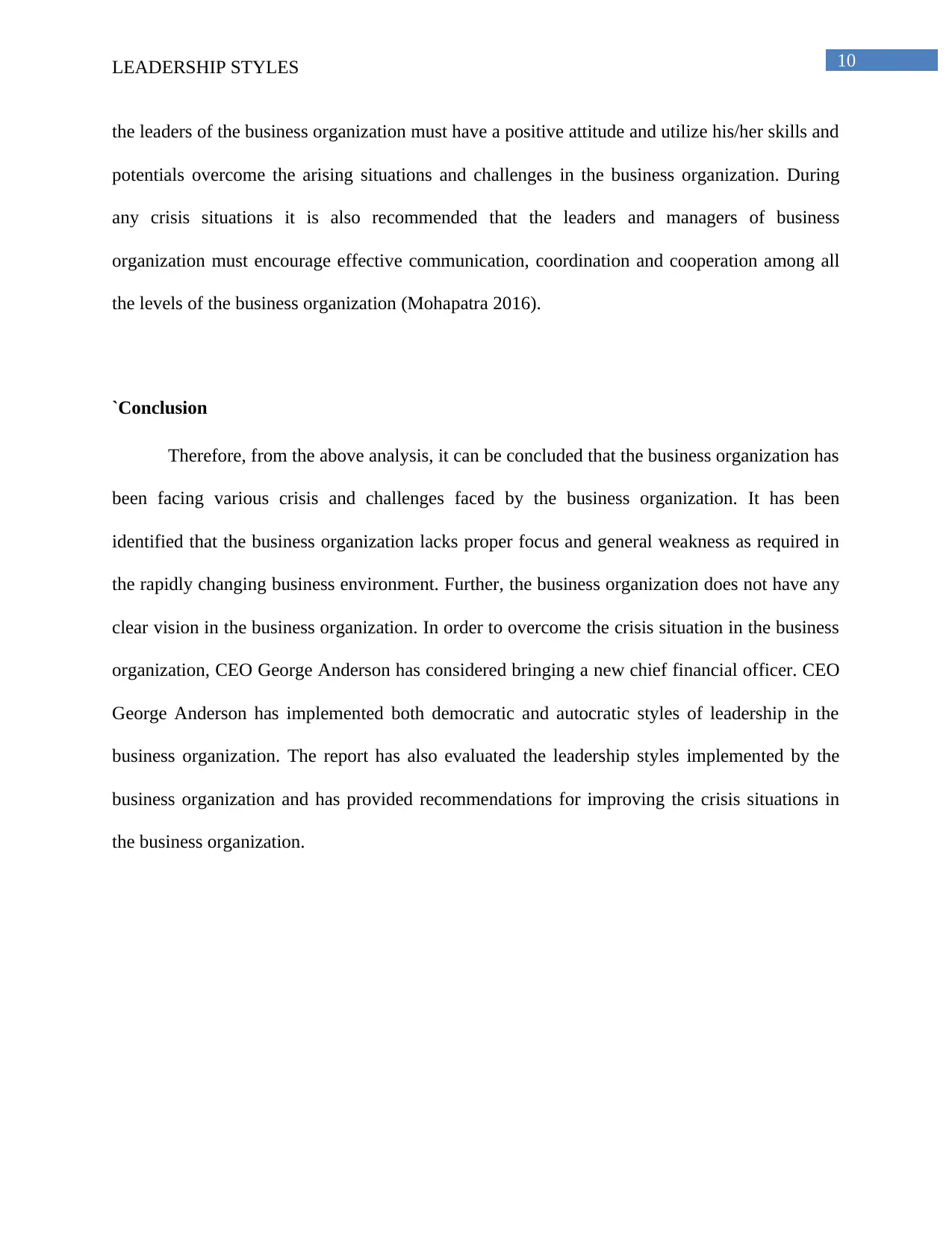
10LEADERSHIP STYLES
the leaders of the business organization must have a positive attitude and utilize his/her skills and
potentials overcome the arising situations and challenges in the business organization. During
any crisis situations it is also recommended that the leaders and managers of business
organization must encourage effective communication, coordination and cooperation among all
the levels of the business organization (Mohapatra 2016).
`Conclusion
Therefore, from the above analysis, it can be concluded that the business organization has
been facing various crisis and challenges faced by the business organization. It has been
identified that the business organization lacks proper focus and general weakness as required in
the rapidly changing business environment. Further, the business organization does not have any
clear vision in the business organization. In order to overcome the crisis situation in the business
organization, CEO George Anderson has considered bringing a new chief financial officer. CEO
George Anderson has implemented both democratic and autocratic styles of leadership in the
business organization. The report has also evaluated the leadership styles implemented by the
business organization and has provided recommendations for improving the crisis situations in
the business organization.
the leaders of the business organization must have a positive attitude and utilize his/her skills and
potentials overcome the arising situations and challenges in the business organization. During
any crisis situations it is also recommended that the leaders and managers of business
organization must encourage effective communication, coordination and cooperation among all
the levels of the business organization (Mohapatra 2016).
`Conclusion
Therefore, from the above analysis, it can be concluded that the business organization has
been facing various crisis and challenges faced by the business organization. It has been
identified that the business organization lacks proper focus and general weakness as required in
the rapidly changing business environment. Further, the business organization does not have any
clear vision in the business organization. In order to overcome the crisis situation in the business
organization, CEO George Anderson has considered bringing a new chief financial officer. CEO
George Anderson has implemented both democratic and autocratic styles of leadership in the
business organization. The report has also evaluated the leadership styles implemented by the
business organization and has provided recommendations for improving the crisis situations in
the business organization.
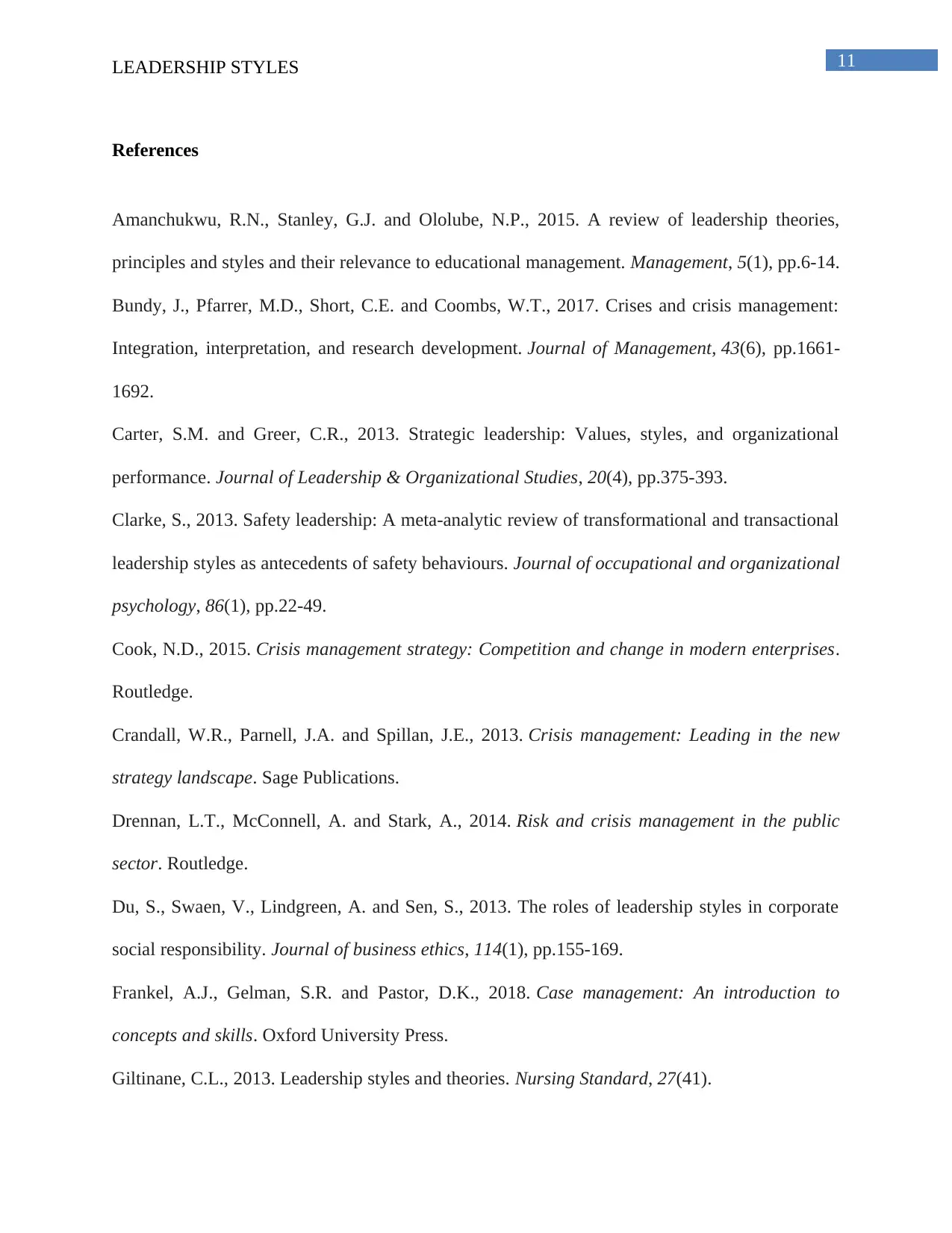
11LEADERSHIP STYLES
References
Amanchukwu, R.N., Stanley, G.J. and Ololube, N.P., 2015. A review of leadership theories,
principles and styles and their relevance to educational management. Management, 5(1), pp.6-14.
Bundy, J., Pfarrer, M.D., Short, C.E. and Coombs, W.T., 2017. Crises and crisis management:
Integration, interpretation, and research development. Journal of Management, 43(6), pp.1661-
1692.
Carter, S.M. and Greer, C.R., 2013. Strategic leadership: Values, styles, and organizational
performance. Journal of Leadership & Organizational Studies, 20(4), pp.375-393.
Clarke, S., 2013. Safety leadership: A meta‐analytic review of transformational and transactional
leadership styles as antecedents of safety behaviours. Journal of occupational and organizational
psychology, 86(1), pp.22-49.
Cook, N.D., 2015. Crisis management strategy: Competition and change in modern enterprises.
Routledge.
Crandall, W.R., Parnell, J.A. and Spillan, J.E., 2013. Crisis management: Leading in the new
strategy landscape. Sage Publications.
Drennan, L.T., McConnell, A. and Stark, A., 2014. Risk and crisis management in the public
sector. Routledge.
Du, S., Swaen, V., Lindgreen, A. and Sen, S., 2013. The roles of leadership styles in corporate
social responsibility. Journal of business ethics, 114(1), pp.155-169.
Frankel, A.J., Gelman, S.R. and Pastor, D.K., 2018. Case management: An introduction to
concepts and skills. Oxford University Press.
Giltinane, C.L., 2013. Leadership styles and theories. Nursing Standard, 27(41).
References
Amanchukwu, R.N., Stanley, G.J. and Ololube, N.P., 2015. A review of leadership theories,
principles and styles and their relevance to educational management. Management, 5(1), pp.6-14.
Bundy, J., Pfarrer, M.D., Short, C.E. and Coombs, W.T., 2017. Crises and crisis management:
Integration, interpretation, and research development. Journal of Management, 43(6), pp.1661-
1692.
Carter, S.M. and Greer, C.R., 2013. Strategic leadership: Values, styles, and organizational
performance. Journal of Leadership & Organizational Studies, 20(4), pp.375-393.
Clarke, S., 2013. Safety leadership: A meta‐analytic review of transformational and transactional
leadership styles as antecedents of safety behaviours. Journal of occupational and organizational
psychology, 86(1), pp.22-49.
Cook, N.D., 2015. Crisis management strategy: Competition and change in modern enterprises.
Routledge.
Crandall, W.R., Parnell, J.A. and Spillan, J.E., 2013. Crisis management: Leading in the new
strategy landscape. Sage Publications.
Drennan, L.T., McConnell, A. and Stark, A., 2014. Risk and crisis management in the public
sector. Routledge.
Du, S., Swaen, V., Lindgreen, A. and Sen, S., 2013. The roles of leadership styles in corporate
social responsibility. Journal of business ethics, 114(1), pp.155-169.
Frankel, A.J., Gelman, S.R. and Pastor, D.K., 2018. Case management: An introduction to
concepts and skills. Oxford University Press.
Giltinane, C.L., 2013. Leadership styles and theories. Nursing Standard, 27(41).
⊘ This is a preview!⊘
Do you want full access?
Subscribe today to unlock all pages.

Trusted by 1+ million students worldwide
1 out of 16
Related Documents
Your All-in-One AI-Powered Toolkit for Academic Success.
+13062052269
info@desklib.com
Available 24*7 on WhatsApp / Email
![[object Object]](/_next/static/media/star-bottom.7253800d.svg)
Unlock your academic potential
Copyright © 2020–2025 A2Z Services. All Rights Reserved. Developed and managed by ZUCOL.





